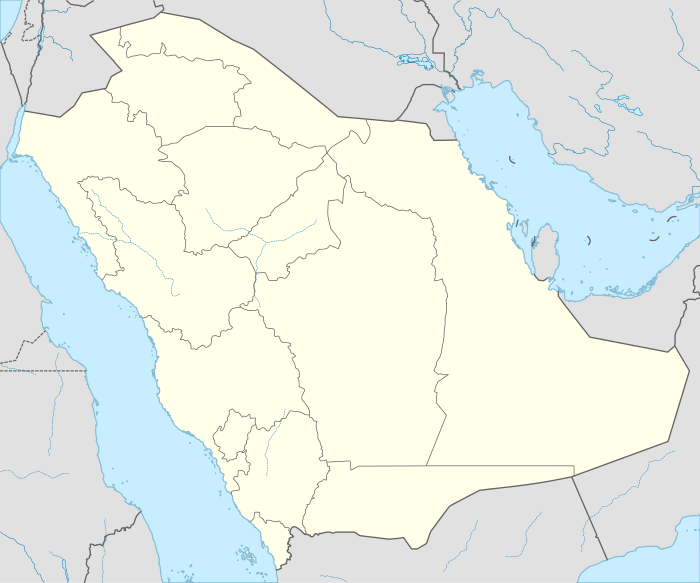Al Hejr
Al-Ḥijr[1][2] (ِArabic: الْحِجْر, lit. 'The Stoneland') is the 15th Quranic chapter (sūrah). It has 99 verses (āyāt).
| الحجر Al-Ḥijr The Stoneland | |
|---|---|
| Classification | Meccan |
| Other names | Al-Hijr Valley |
| Position | Juzʼ 14 |
| Hizb no. | 27 |
| No. of Rukus | 6 |
| No. of verses | 99 |
| No. of Sajdahs | none |
| Quran |
|---|
 |
|
Al-Hijr or Mada'in Salih | |
 Shown within Saudi Arabia | |
| Alternative name | Al-Hijr ٱلْحِجْر Hegra |
|---|---|
| Location | Al Madinah Region, Al-Hejaz, Saudi Arabia |
| Coordinates | 26°47′30″N 37°57′10″E |
| Type | Settlement |
| Official name | Al-Hijr Archaeological Site (Madâ’in Sâlih) |
| Type | Cultural |
| Criteria | ii, iii |
| Designated | 2008 (32nd session) |
| Reference no. | 1293 |
| Region | Arab States |
Regarding the timing and contextual background of the revelation (asbāb al-nuzūl), it is an earlier Meccan surah, believed to have been received by Prophet Muhammad shortly after chapter 12, Yusuf, during his last year in Mecca. Like other surahs of this period, it praises God. Parts of Q15:4-74 are preserved in the Ṣan‘ā’1 lower text.[3]
Name
This Surah takes its name from 80th ayat [4] which refers to Mada'in Saleh, a pre-Islamic archaeological site, occasionally called Al-Hijr, or Hegra.
Time of Revelation
The revelation of this surah occurred at a similar time to that of Surah Ibrahim. Its also repeats the admonitions. Muhammad had been spreading the message for a long time. His kin had become increasingly stiff-necked and obstinate in their hostility, hatred and mocking. Muhammad had started to feel tired in his attempts against disbelief and restrictions of his people. Allah reassured him again.[5]
Central Theme
This surah contains brief mentions of Tawhid, and provides an admonition to the disbelievers. The primary subjects of the surah are:
- cautioning the individuals who dismissed the message and
- providing solace and support to Muhammad,
The Quran never limits itself to mere rebuke; reproach and reprimand. It depends on its statute. The surah contains brief contentions for Tawhid and admonition in the tale of Adam and Satan.[6]
Exegesis
Q15:9
15:9 We have, without doubt, sent down the Message; and We will assuredly guard it (from corruption). Translation Yusuf Ali (Orig. 1938) [7]
Ibn Kathir says, "God, may He be exalted, stated that He is the One Who revealed the Dhikr to him, which is the Qur'an, and He is protecting it from being changed or altered".[2]
Principal Subjects
The significant issues, divine laws, and prevailing Guidance in this surah is that the Qur'an is a Divine Book, the doubters will wish that they had become Muslims on the Day of Judgment, Allah Himself has assumed the liability of saving and preserving Al-Qur'an. Warning by the tale of Adam's creation, prostration of the angels before him, and refusal of Shaitan to prostrate. The Prophet Ibrahim was given the uplifting news of having a child by a similar two angels who were relegated to decimate the nation of Lut. Al-Fatiha is likewise named, "seven ayaat deserving of oft-recitation." Divine command to declare the edicts of Allah publicly and get some distance from the mushrikin.
| Ayaat | Subject[8] |
|---|---|
| 1-3 | Unbelievers will wish themselves Muslims one day |
| 4, 5 | Every nation has its day of grace |
| 6 | Muhammad accused of demoniacal possession |
| 7 | The unbelievers state a genuine prophet would have accompanied by angels |
| 8 | Angels are not sent to satisfy interest, yet to serve judgment |
| 9 | God the author and preserver of the Qurán |
| 10,11 | The previous prophets were giggled to scorn |
| 12-15 | The sneering Quraish judicially blinded |
| 16-20 | God announces his brilliance in the heaven and the earth |
| 21, 22 | He is active in all aspects of Nature |
| 23-25 | He is the God of life, demise, and judgment |
| 26-29 | Men created from clay, the genii from fire |
| 29-33 | Iblís refused to prostrate in front of Adam |
| 34-38 | He is cursed and given respite until the day of judgment |
| 39, 40 | Satan proclaims to God his purpose to lure men |
| 41, 42 | The chosen are sheltered from Satan's power |
| 43, 44 | The seven doors of hellfire will get Satan's followers |
| 45-50 | Paradise delights available for true believers |
| 51-77 | The recollection of Abraham and Lot |
| 78, 79 | The unbelieving Midianites are destroyed |
| 80, 81 | The jeering occupants of Al Hajr rejected their prophets who was accompanied with miracles |
| 82, 84 | Rock-hewn houses failed to save them |
| 85, 862 | The heaven and earth made in righteousness |
| 87 | Order to rehash the seven verses (Al-Fatiha) |
| 88-90 | Muhammad not to envy the flourishing of infidels |
| 91-93 | The enemies of God will without a doubt be punished |
| 94-99 | Muhammad commanded to preach boldly and to praise and serve GOD until death |
Notes
- George Sale translation: Al Hejr
- Ibn Kathir. "Tafsir Ibn Kathir (English): Surah Al Hijr". Quran 4 U. Archived from the original on 28 October 2019. Retrieved 20 April 2020.
- Behnam Sadeghi & Mohsen Goudarzi, "Sana'a and the Origins of the Qu'ran", Der Islam, 87 (2012), 37.
- http://corpus.quran.com/wordmorphology.jsp?location=(15:80:4)
- Abul A'la Maududi - Tafhim-ul-Quran
- Muhammad Farooq-i-Azam Malik (translator), Al-Qur'an, the Guidance for Mankind - English with Arabic Text (Hardcover) ISBN 0-911119-80-9
- "Quran 15:9 Translation Yusuf Ali (Orig. 1938)". Islam Awakened. Archived from the original on 1 January 2020. Retrieved 20 April 2020.
- Mohammed, A Comprehensive Commentary on the Quran: Comprising Sale’s Translation and preliminary Discourse, with Additional Notes and Emendations (London: Kegan Paul, Trench, Trubner, and Co., 1896). 4 vols.
References
- Abdullah, A. (2011). Role of context and objectives of the Surah in shaping the episodes of the Qurʼanic narrative: the narrative of Lot as an example. American Journal of Islamic Social Sciences, 28(4), 31-64.
- Boullata, I. J. (2000). Literary structures of religious meaning in the Qurʼān. London: Curzon Pr.
- Haggar, D. A.Repetition: A key to qur'anic style, structure and meaning. (Order No. AAI3447474, Dissertation Abstracts International, A: The Humanities and Social Sciences, 1661.
- Neuwirth, A. (2000). Referentiality and textuality in Sūrat al-Hijr: Some observations on the Qur'ānic "canonical process" and the emergence of a community. (pp. 143–172). Curzon.
- Ohlander, E. S. (2010). Qur'anic studies. (pp. 81–93). De Gruyter.